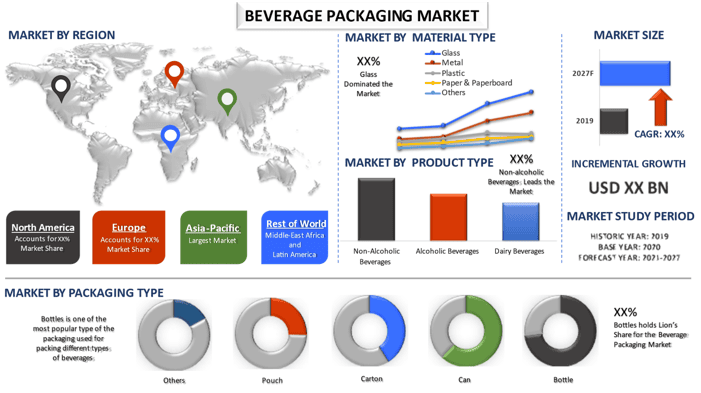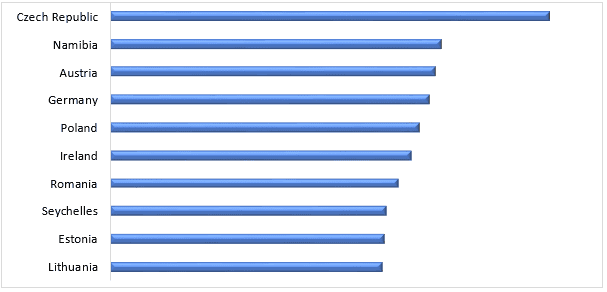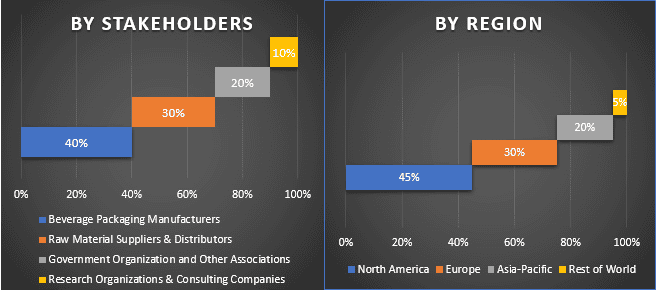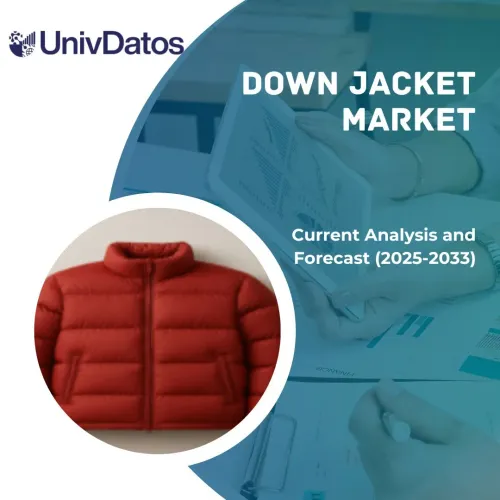- الرئيسية
- معلومات عنا
- صناعة
- الخدمات
- قراءة
- اتصل بنا
سوق تغليف المشروبات: التحليل الحالي والتوقعات (2021-2027)
التركيز على نوع التغليف (زجاجة، علبة، كرتون، كيس، أخرى)؛ نوع المادة (معدن، بلاستيك، زجاج، ورق & ورق مقوى، أخرى)؛ نوع المنتج (مشروبات كحولية، مشروبات غير كحولية، مشروبات ألبان)؛ المستخدم النهائي (مزارعون تجاريون، معاهد بحثية & تعليمية، حدائق البيع بالتجزئة، أخرى)؛ المنطقة/الدولة

بلغ حجم سوق تعبئة المشروبات العالمي حوالي 136 مليار دولار أمريكي في عام 2020، ومن المتوقع أن يصل إلى أكثر من 192 مليار دولار أمريكي بحلول عام 2027، مسجلاً معدل نمو سنوي مركب مرتفع يبلغ حوالي 6٪ خلال الفترة المتوقعة (2021-2027). تعتبر تعبئة المشروبات جانبًا مهمًا في صناعة المشروبات، حيث تلعب دورًا حيويًا في حماية وإطالة العمر الافتراضي لمختلف المشروبات. تتم التعبئة باستخدام أنواع مختلفة من المواد الخام وأنواع العبوات.
زاد استهلاك الكحول في البلدان ذات الدخل المنخفض والمتوسط، بينما ظل الاستهلاك في البلدان ذات الدخل المرتفع ثابتًا أو انخفض بشكل كبير، خاصة في أوروبا. بين عامي 2010 و 2017، كانت الزيادة الأعلى في فيتنام، حيث ارتفع نصيب الفرد من الاستهلاك بنسبة 90 في المائة، من 4.7 لترات إلى 8.9 لترات. وعلى الطرف الآخر من الطيف، سجلت أذربيجان انخفاضًا بنسبة 82٪ في استهلاك الكحول. تتمتع مولدوفا بأعلى معدل لاستهلاك الكحول (15 لترًا للفرد البالغ سنويًا)، بينما الكويت لديها أدنى معدل (0.005 لتر للشخص الواحد سنويًا). نظرًا لهذا الطلب المرتفع على المشروبات الكحولية، يشهد سوق تعبئة المشروبات ارتفاعًا في جميع أنحاء العالم.
علاوة على ذلك، مع تزايد المخاوف بشأن تدهور البيئة، يتبنى العديد من الشركات المصنعة الرائدة للعبوات حلول تعبئة قابلة للتحلل الحيوي وصديقة للبيئة، مما يتسبب في جذب كبير بين المستهلكين على مستوى العالم. وقد ساعد ذلك العديد من العلامات التجارية على إنشاء قاعدة عملاء مخلصة ومسؤولة، وبالتالي زيادة مبيعات منتجاتها حيث تلعب تصميمات التعبئة دورًا حيويًا في هذه الصناعة. على سبيل المثال، في ديسمبر 2019، أطلقت شركة Tetra Pak حل تعبئة بوليمر نباتي لمنتجاتها من الأطعمة والمشروبات. أيضًا، وفقًا لنائب رئيس الاستدامة، ماريو أبرو، يبحث أكثر من 90٪ من العملاء حاليًا عن شعارات بيئية على العبوات عند التسوق. لذلك، هناك زيادة في عدد العلامات التجارية التي تتحول نحو حلول التعبئة المستدامة. وبالتالي، تعزيز سوق تعبئة المشروبات.
استهلاك البيرة (لتر للفرد)، حسب البلدان المختارة، 2021

تعد Amcor PLC و Crown Holdings و Ardagh Group و Mondi PLC و RPC Group PLC و Tetra Laval International SA و Berry Global Inc. و Ball Corporation و Sonoco Products Company و Toyo Seikan Group، من بين اللاعبين البارزين العاملين في سوق تعبئة المشروبات. تم إجراء العديد من عمليات الاندماج والاستحواذ بالإضافة إلى الشراكات من قبل هؤلاء اللاعبين لتزويد العملاء بأنواع جديدة من عبوات المشروبات.
رؤى مقدمة في التقرير
"من بين أنواع التعبئة والتغليف، يحمل قطاع الزجاجات الحصة الأكبر"
استنادًا إلى نوع التعبئة والتغليف، يتم تقسيم السوق إلى زجاجة، وعلبة، وكرتون، وكيس، وغيرها. هيمن قطاع الزجاجات على سوق تعبئة المشروبات ومن المتوقع أن ينمو بمعدل نمو سنوي مركب كبير خلال السنوات القادمة حيث أنه أحد أكثر أنواع التعبئة شيوعًا المستخدمة لتعبئة أنواع مختلفة من المشروبات. بصرف النظر عن ذلك، فإن عوامل مثل سهولة النقل والتخزين تجعله الخيار الأكثر تفضيلاً من قبل المستهلكين. ومع ذلك، من المتوقع أيضًا أن يشهد قطاع الكرتون نموًا كبيرًا خلال الفترة المتوقعة.
"من بين أنواع المواد، يحمل قطاع الزجاج الحصة الأكبر"
استنادًا إلى نوع المادة، تم تقسيم سوق تعبئة المشروبات إلى معادن، وبلاستيك، وزجاج، وورق ولوح كرتون، وغيرها. من المتوقع أن يحصد قطاع الزجاج الحصة الأكبر في السوق في عام 2020 وسينمو بمعدل نمو سنوي مركب ملحوظ حيث يتم استخدام مادة الزجاج على نطاق واسع في صناعة الزجاجات والمرطبانات المستخدمة لتعبئة المشروبات المتنوعة. ومع ذلك، من المتوقع أيضًا أن ينمو قطاع المعادن بمعدل نمو سنوي مركب كبير في السنوات القادمة نظرًا للمرونة والراحة التي توفرها التعبئة المعدنية. يمكن استخدام أنواع مختلفة من المعادن للتعبئة والتغليف المتوفرة على نطاق واسع بما في ذلك الألومنيوم والفولاذ.
"من بين أنواع المنتجات، يحمل قطاع المشروبات غير الكحولية الحصة الأكبر"
استنادًا إلى نوع المنتج، يتم تقسيم السوق إلى مشروبات كحولية ومشروبات غير كحولية ومشروبات الألبان. استحوذ قطاع المشروبات غير الكحولية على حصة كبيرة من الإيرادات في عام 2020 ومن المتوقع أن ينمو بمعدل نمو سنوي مركب كبير خلال الإطار الزمني المتوقع بسبب ارتفاع استهلاك مختلف المشروبات غير الكحولية مثل العصائر والهريس والصلصات والمشروبات الغازية والمشروبات الغازية وغيرها. على سبيل المثال، في الهند، بلغ استهلاك المشروبات الغازية 44 زجاجة للفرد في عام 2016، وهو أقل من الاختراق ومن المرجح أن يتضاعف إلى 84 زجاجة بحلول عام 2021.
"من بين المستخدمين النهائيين، يحمل قطاع الأغذية الحصة الأكبر"
استنادًا إلى المستخدم النهائي، يتم تقسيم السوق إلى المزارعين التجاريين ومعاهد البحث والتعليم والحدائق البيع بالتجزئة وغيرها. استحوذ قطاع معاهد البحث والتعليم على حصة سوقية كبيرة في عام 2020 ومن المتوقع أيضًا أن ينمو بوتيرة كبيرة في السنوات القادمة. يمكن أن يعزى نمو هذا القطاع إلى النمو في عدد الشركات التي تقدم عبوات مشروبات صغيرة أو كبيرة لإجراء أنشطة بحثية مختلفة. على سبيل المثال، تقوم شركة Nexus Corporation بتصميم مرافق بحثية حديثة تبلغ مساحتها 15000 قدم مربع، بالإضافة إلى عبوات مشروبات تبلغ مساحتها 500 قدم مربع لبرامج المدارس الثانوية.
"تمثل منطقة آسيا والمحيط الهادئ واحدة من أكبر أسواق سوق تعبئة المشروبات"
لفهم أفضل لديناميكيات سوق تعبئة المشروبات، تم إجراء تحليل تفصيلي لمختلف المناطق في جميع أنحاء العالم بما في ذلك أمريكا الشمالية (الولايات المتحدة وكندا وبقية أمريكا الشمالية) وأوروبا (ألمانيا وفرنسا وإسبانيا والمملكة المتحدة وإيطاليا وبقية أوروبا) وآسيا والمحيط الهادئ (الصين واليابان والهند وأستراليا وبقية منطقة آسيا والمحيط الهادئ)، وبقية العالم. تشكل منطقة آسيا والمحيط الهادئ سوقًا رئيسيًا لصناعة سوق تعبئة المشروبات وحققت إيرادات قدرها XX مليون دولار أمريكي في عام 2020 نظرًا لوجود لاعبين راسخين في السوق.
أسباب شراء هذا التقرير:
- تتضمن الدراسة تحليل لحجم السوق والتنبؤ به تم التحقق منه من قبل خبراء الصناعة الرئيسيين المعتمدين
- يقدم التقرير مراجعة سريعة للأداء العام للصناعة في لمحة
- يغطي التقرير تحليلًا متعمقًا لنظراء الصناعة البارزين مع التركيز الأساسي على البيانات المالية الرئيسية للأعمال، ومجموعة المنتجات، واستراتيجيات التوسع، والتطورات الأخيرة
- فحص مفصل للدوافع والقيود والاتجاهات الرئيسية والفرص السائدة في الصناعة
- تغطي الدراسة السوق بشكل شامل عبر قطاعات مختلفة
- تحليل متعمق على المستوى الإقليمي للصناعة
خيارات التخصيص:
يمكن زيادة تخصيص سوق تعبئة المشروبات العالمي وفقًا للمتطلبات أو أي شريحة سوقية أخرى. إلى جانب ذلك، تدرك UMI أن لديك احتياجات عملك الخاصة، لذا لا تتردد في التواصل معنا للحصول على تقرير يناسب متطلباتك تمامًا.
جدول المحتويات
كان تحليل السوق التاريخي، وتقدير السوق الحالي، والتنبؤ بالسوق المستقبلي لسوق تعبئة المشروبات العالمي هي الخطوات الرئيسية الثلاث التي تم اتخاذها لإنشاء وتحليل اعتماد تعبئة المشروبات في المناطق الرئيسية على مستوى العالم. تم إجراء بحث ثانوي شامل لجمع أرقام السوق التاريخية وتقدير حجم السوق الحالي. ثانيًا، للتحقق من صحة هذه الرؤى، تم أخذ العديد من النتائج والافتراضات في الاعتبار. علاوة على ذلك، تم إجراء مقابلات أولية شاملة أيضًا مع خبراء الصناعة عبر سلسلة القيمة لسوق تعبئة المشروبات العالمي. بعد افتراض أرقام السوق والتحقق من صحتها من خلال المقابلات الأولية، استخدمنا نهجًا تصاعديًا / تنازليًا للتنبؤ بحجم السوق الكامل. بعد ذلك، تم اعتماد طرق تقسيم السوق وتثليث البيانات لتقدير وتحليل حجم السوق للقطاعات والقطاعات الفرعية التي تنتمي إليها الصناعة. يتم شرح المنهجية التفصيلية أدناه:
تحليل حجم السوق التاريخي
الخطوة 1: دراسة متعمقة للمصادر الثانوية:
تم إجراء دراسة ثانوية مفصلة للحصول على حجم السوق التاريخي لتعبئة المشروبات من خلال مصادر الشركة الداخلية مثل التقرير السنوي والبيانات المالية، وعروض الأداء، والنشرات الصحفية، وما إلى ذلك، والمصادر الخارجية بما في ذلك المجلات والأخبار والمقالات والمنشورات الحكومية ومنشورات المنافسين وتقارير القطاعات وقاعدة بيانات الطرف الثالث والمنشورات الموثوقة الأخرى.
الخطوة 2: تقسيم السوق:
بعد الحصول على حجم السوق التاريخي لسوق تعبئة المشروبات، أجرينا تحليلًا ثانويًا مفصلاً لجمع رؤى السوق التاريخية وحصتها للقطاعات والقطاعات الفرعية المختلفة للمناطق الرئيسية. تضمنت القطاعات الرئيسية المدرجة في التقرير نوع التعبئة ونوع المادة ونوع المنتج. تم إجراء المزيد من التحليلات على المستوى القطري لتقييم الاعتماد الكلي لتعبئة المشروبات في جميع أنحاء العالم.
الخطوة 3: تحليل العوامل:
بعد الحصول على حجم السوق التاريخي للقطاعات والقطاعات الفرعية المختلفة، أجرينا تحليل عوامل مفصلاً لتقدير حجم السوق الحالي لتعبئة المشروبات. علاوة على ذلك، أجرينا تحليلًا للعوامل باستخدام متغيرات تابعة ومستقلة مثل الاعتماد المتزايد لتعبئة المشروبات في مختلف القطاعات. تم إجراء تحليل شامل لسيناريوهات الطلب والعرض مع الأخذ في الاعتبار أفضل الشراكات والاندماج والاستحواذ والتوسع التجاري وإطلاق المنتجات في قطاع تعبئة المشروبات في جميع أنحاء العالم.
تقدير حجم السوق الحالي والتنبؤ به
تحديد حجم السوق الحالي: بناءً على رؤى قابلة للتنفيذ من الخطوات الثلاث المذكورة أعلاه، توصلنا إلى حجم السوق الحالي واللاعبين الرئيسيين في سوق تعبئة المشروبات والحصص السوقية للقطاعات. تم تحديد جميع الحصص المئوية المطلوبة وتقسيمات السوق باستخدام النهج الثانوي المذكور أعلاه وتم التحقق منها من خلال المقابلات الأولية.
التقدير والتنبؤ: لتقدير السوق والتنبؤ به، تم تخصيص أوزان لعوامل مختلفة بما في ذلك المحركات والاتجاهات والقيود والفرص المتاحة لأصحاب المصلحة. بعد تحليل هذه العوامل، تم تطبيق تقنيات التنبؤ ذات الصلة، أي النهج التصاعدي / التنازلي، للوصول إلى توقعات السوق بحلول عام 2027 للقطاعات والقطاعات الفرعية المختلفة عبر الأسواق الرئيسية على مستوى العالم. تشتمل منهجية البحث المعتمدة لتقدير حجم السوق على:
- حجم سوق الصناعة، من حيث القيمة (بالدولار الأمريكي) ومعدل اعتماد تعبئة المشروبات عبر الأسواق الرئيسية محليًا
- جميع الحصص المئوية والانقسامات والتقسيمات الفرعية لقطاعات السوق والقطاعات الفرعية
- اللاعبين الرئيسيين في سوق تعبئة المشروبات من حيث المنتجات المعروضة. أيضًا، استراتيجيات النمو التي يتبناها هؤلاء اللاعبون للتنافس في السوق سريع النمو
التحقق من صحة حجم السوق وحصته
البحث الأولي: تم إجراء مقابلات متعمقة مع قادة الرأي الرئيسيين (KOLs) بمن فيهم كبار المسؤولين التنفيذيين (CXO / VPs ورئيس المبيعات ورئيس التسويق والرئيس التشغيلي والرئيس الإقليمي ورئيس الدولة وما إلى ذلك) عبر المناطق الرئيسية. تم بعد ذلك تلخيص نتائج البحث الأولي وإجراء تحليل إحصائي لإثبات الفرضية المذكورة. تم دمج المدخلات من البحث الأولي مع النتائج الثانوية، وبالتالي تحويل المعلومات إلى رؤى قابلة للتنفيذ.
تقسيم المشاركين الأساسيين في مناطق مختلفة

هندسة السوق
تم استخدام تقنية تثليث البيانات لإكمال تقدير السوق الإجمالي والوصول إلى أرقام إحصائية دقيقة لكل قطاع وقطاع فرعي من سوق تعبئة المشروبات. تم تقسيم البيانات إلى عدة قطاعات وقطاعات فرعية بعد دراسة المعلمات والاتجاهات المختلفة في مجالات نوع التعبئة ونوع المادة ونوع المنتج في سوق تعبئة المشروبات.
الهدف الرئيسي من دراسة سوق تعبئة المشروبات
تم تحديد اتجاهات السوق الحالية والمستقبلية لتعبئة المشروبات في الدراسة. يمكن للمستثمرين اكتساب رؤى استراتيجية لبناء تقديرهم للاستثمارات من التحليل النوعي والكمي الذي تم إجراؤه في الدراسة. تم تحديد اتجاهات السوق الحالية والمستقبلية للجاذبية الكلية للسوق على المستوى الإقليمي، مما يوفر منصة للمشارك الصناعي لاستغلال السوق غير المستغل للاستفادة كميزة المحرك الأول. تشمل الأهداف الكمية الأخرى للدراسات ما يلي:
- تحليل حجم السوق الحالي والمتوقع لتعبئة المشروبات من حيث القيمة (بالدولار الأمريكي). أيضًا، قم بتحليل حجم السوق الحالي والمتوقع للقطاعات والقطاعات الفرعية المختلفة
- تشمل القطاعات في الدراسة مجالات نوع التعبئة ونوع المادة ونوع المنتج
- تحديد وتحليل الإطار التنظيمي لصناعة تعبئة المشروبات
- تحليل سلسلة القيمة المتضمنة مع وجود وسطاء مختلفين، إلى جانب تحليل سلوكيات العملاء والمنافسين في الصناعة
- تحليل حجم السوق الحالي والمتوقع لسوق تعبئة المشروبات للمنطقة الرئيسية
- تشمل المناطق الرئيسية التي تمت دراستها في التقرير أمريكا الشمالية وأوروبا وآسيا والمحيط الهادئ وبقية العالم
- ملفات تعريف الشركات لسوق تعبئة المشروبات واستراتيجيات النمو التي يتبناها اللاعبون في السوق للاستمرار في السوق سريع النمو
- تحليل متعمق على المستوى الإقليمي للصناعة
ذات صلة التقارير
العملاء الذين اشتروا هذا المنتج اشتروا أيضًا










